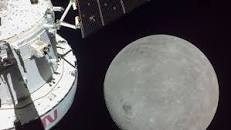NASA’s Orion spacecraft flies by the moon, 81 miles above the surface

Five days after launching from the Kennedy Space Center, NASA’s Orion spacecraft reached the moon Monday, passing within 81 miles of the lunar surface and marking the completion of a key step in the space agency’s Artemis campaign to return astronauts there within a few years.
The spacecraft’s service module autonomously fired its engines at 7:44 a.m. Eastern time for 2½ minutes while it flew behind the moon and was out of communications with ground controllers. The burn propelled the capsule toward an orbit around the moon that was expected to reach 268,552 miles from Earth, farther than any spacecraft designed for human spaceflight has flown and breaking a record set during the Apollo 13 mission.
The flight, known as Artemis I, does not have any people on board and will not land on the moon. Instead, it is a test flight ahead of the Artemis II mission that will also orbit the moon, this time with astronauts. That could come as early as 2024, with a human landing as early as 2025 or 2026 — which would mark the first time humans have walked on the moon since the last of the Apollo missions in 1972.
As the capsule emerged from the far side of the moon and beamed back photos of Earth in the distance, NASA’s Sandra Jones said on the agency’s live broadcast: “Standing on the shoulders of the giants of the Apollo generation, Orion now carries forward the torch of the Artemis generation, as it emerges from behind the moon. And Earth rise of our pale blue dot and its 8 billion inhabitants now coming into view.”
s it passed around the moon, it flew about 1,300 miles above Tranquility Base, the Apollo 11 landing site of Neil Armstrong and Buzz Aldrin, NASA said. The sites were in darkness at the time, Artemis I flight director Judd Frieling said during a briefing hours later. But the spacecraft is scheduled to fly over the sites on its return trip, when they would be in sunlight.
“We’re working on a plan to see if we can get pictures of those Apollo landing sites as we’re flying back,” he said.
In a statement, NASA Administrator Bill Nelson called it “a huge step for the Artemis I mission and critical to understanding our spacecraft before we fly astronauts on it to the Moon. Congratulations to the tens of thousands of team members and partners who have gotten us to this point. This is not just your achievement but one for humanity.”
Leading up to Monday’s engine burn, known as the “outbound powered flyby,” Mike Sarafin, the Artemis I mission manager, said the spacecraft “is exceeding performance expectations,” and officials at NASA’s Johnson Space Center in Houston gave the “go” to fire the engine. The capsule was built by Lockheed Martin, and the service module was supplied by the European Space Agency in a partnership with NASA. The engine that performed the burn was repurposed from the space shuttle and had flown 19 missions between 1984 and 2002.
“Things are going really well,” Sarafin said in a briefing Monday evening. He said the spacecraft and its systems “continue to exceed expectations.”
On Friday, the spacecraft will enter what is known as a “distant retrograde orbit,” a stable trajectory high above the lunar surface that flies the opposite direction than the moon travels around Earth. The orbit was chosen because “little fuel is required to stay for an extended trip in deep space,” according to NASA, as it tests systems such as guidance, navigation, communications and power as the space agency prepares to return humans to the moon.
Orion will stay in that orbit for about six days before firing its engine again, putting it on a path toward home. It is expected to splash down in the Pacific Ocean off the coast of San Diego on Dec. 11, completing a 25½-day mission.
Unlike the Apollo program, which was driven by the Cold War space race with the Soviet Union, Artemis seeks to create a permanent presence on and around the moon. NASA plans to eventually put a spacecraft called the Gateway into lunar orbit that would be used as a staging area for astronauts as they ferry to and from the lunar surface.
For its human landings, NASA is targeting the south pole of the moon, where there is water in the permanently shadowed craters.
